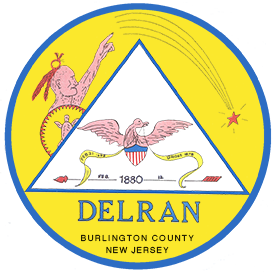About Delran
Seal of Delran
- Circle
A circle of persons united by a common bond. Representing your present Mayor and Council government of Delran Township. - Sun
A time of happiness and prosperity. Lenape Indians – the people at the rising of the sun. - Triangle and Eagle
Eagle and the Red White and Blue shield signifies Americano. I am sure this was in the mind of Peter Coppuck, the artist, who painted the lettering on the Bridgeboro bridge, and the emblem of a flying eagle with shield. The triangle represents the Bridge built in 1838, which was painted white.
Creation of Delran Township – An Act
- To divide the township of Cinnaminson into two townships, whereas: The inhabitants of the township of Cinnaminson in the County of Burlington, NJ have become so numerous that it is impractical for them to meet and transact the township business at their annual and other town meetings, with convenience and good order in one assembly. For remedy whereof, by an act of the Senate and Assembly of the State of New Jersey, Cinnaminson was divided into two townships. February 12, 1880.
Chester Township
- Incorporated February 21, 1698. It is supposed to have been named after Chester in England, and sprang up during the Roman Dominion, as a stationary camp. Chester Township formerly included Cinnaminson, Riverton, Palmyra, Moorestown, Maple Shade, Riverside and Delran. Chester Avenue and the Chester Street School are all that is left that reminds us of this township.
Our First Inhabitants
- The first Indians, as we know them to be, were the Lenni Lenape or Delaware Indians, so named by the English in 1610; they divided roughly into three bands. The first of these Indian clans lived in the upper Delaware River valley; they were known as the Minsi and their symbol was the Wolf. Further down the Delaware river and scattered along it’s bank lived the second of the three Indian divisions known as the Unami; their totem was the tortoise. The third and last was the Unalachtigo. These Indians were scattered along the South Jersey coast. Their symbol was the turkey. Lenni Lenape means real men-manly men or original people. New Jersey was called Sykeyechbi by the Indians and the Delaware River was Wihittuck, which means the river of the Lenape; the people of the rising sun. These tribes belong to the Algomken Nation, so named by the French, and called them Wolves.
Passing of the Indians
- In 1680 it was said that an old Indian Chief, presumedly Chief Ockananickon of the Unami or Turtle Tribe, on seeing the great comet, signified that the Indians shall melt away in this country, and be occupied by other people. Chief Ockananickon died in 1682; is buried in Friends Burial grounds in Burlington. The last Delaware Indians lived near the Rancocas Creek. Indian Ann lived until 1894 and was a hundred years old. Indian legend has it that a comet was responsible for predicting wars.
Arrow
- In a line in order. The arrow for the Lenni Lenape Indians was their staff of life, a broken arrow meant war.
Turtle on Shield
- To the Unanun it meant Creation and Protection. Lenape believed that all things came from the tortoise. It brought forth the world and from the middle of it’s back had sprung up a tree, upon whose branches men had grown. This tortoise “had a power and a nature to produce all things, such as earth, trees and the like.” But it was not the ultimate energy of the universe. The first and great beginning of all things was “Kickerom” who was the orginator of all, who not only produced or made all things, but produced every day. (Manito Spirit). The tortoise brought forth what this primated divinity “wished through it to produce” Of course there are other versions of Indian myths.
-Fred Wolff, Historian
